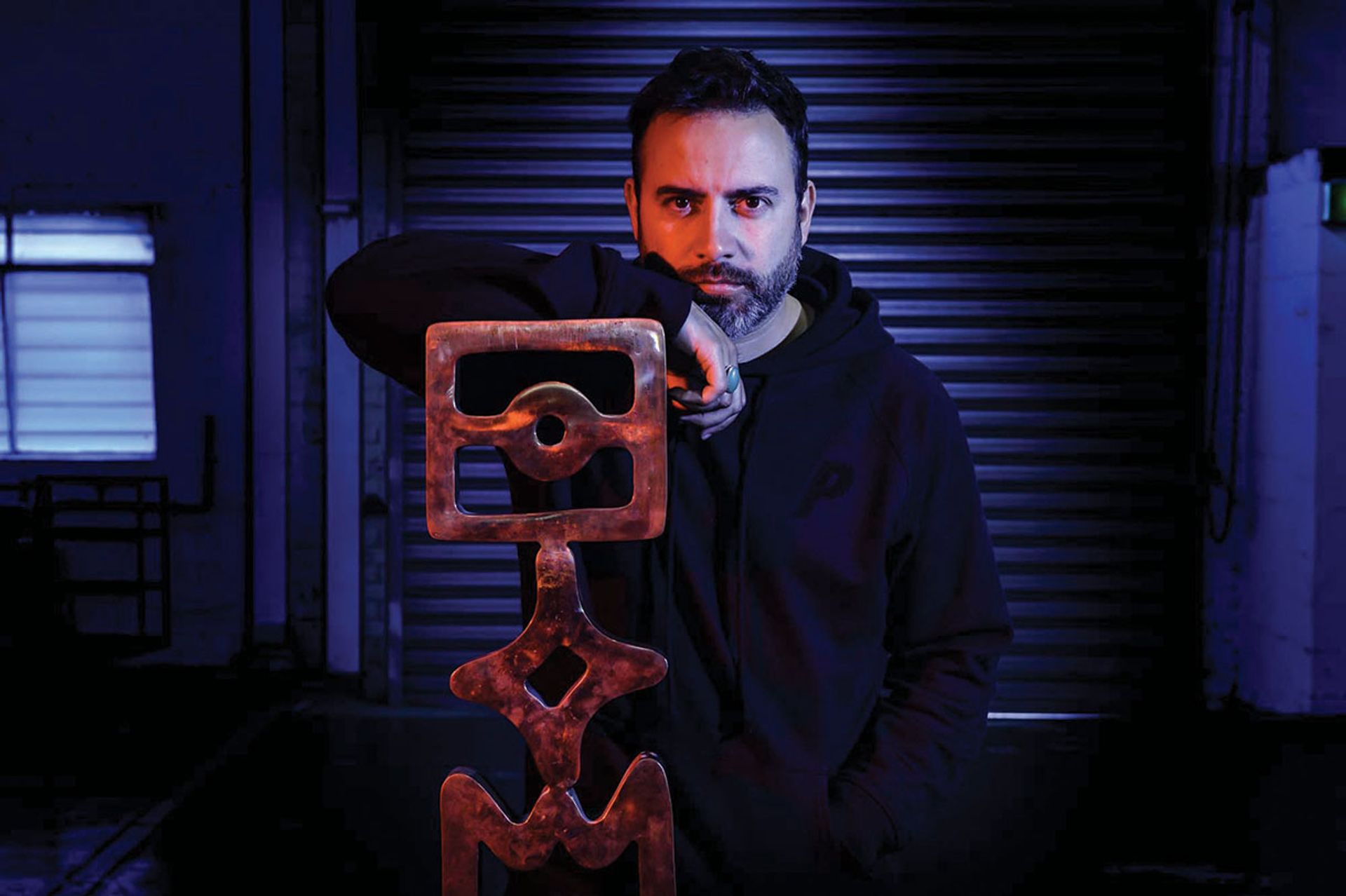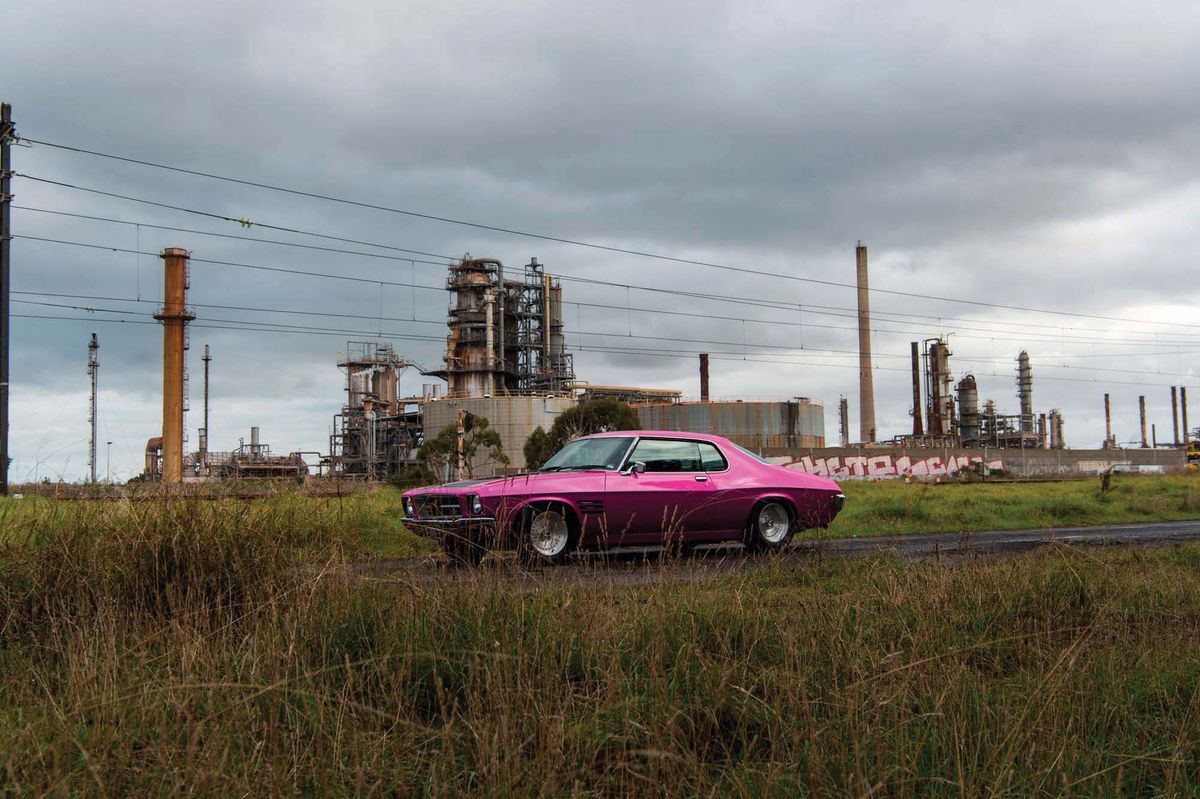Looking suave at the wheel of a 1973 Holden Monaro coupé, the Australian artist Reko Rennie cruises past factories and shipping containers on the industrial outskirts of Melbourne. The Monaro’s new paint job is in luscious pink with black speed stripes. It is night and the glitter of the distant city makes Rennie’s deserted streets more sinister.
To the soundtrack of an operatic soprano and the Melbourne Symphony Orchestra, Rennie guns the engine and pulls the steering wheel to full lock. The Monaro slides into tight donuts that send up clouds of dirt and tyre smoke.
This is Initiation OA_RR (2021), Rennie’s eight-minute film in which the artist returns to the streets of his youth, where drugs, alcohol, drag racing and police charge sheets were part of everyday life.
In asking the distinguished Yorta Yorta soprano Deborah Cheetham to compose music for the work, Rennie paid homage to his grandmother Julia Rennie, whose aspirations to be an opera soprano went cruelly unrealised when she won a singing scholarship but her employers refused to give her time off to pursue it.
Julia was part of Australia’s “stolen generations”, having been forcibly removed from her parents as a child and placed on a mission where she was trained in domestic duties for her future of servitude on various pastoral properties. Australia’s 1997 study, Bringing them Home: The Report of the National Inquiry into the Separation of Aboriginal and Torres Strait Islander Children from Their Families, exposed the tragic truth of the stolen generations.

Reko Rennie is one of 25 artists chosen by Sebastian Goldspink, guest curator of this year’s edition of the Adelaide Biennial, for the event © Reko Rennie and Justin McManus
Like Rennie’s grandmother, many young girls indentured as servants on rural properties “were basically there for the pickings of pastoral owners and workers”, Rennie says.
Sebastian Goldspink, the guest curator of the Adelaide Biennial of Australian Art at the Art Gallery of South Australia (4 March-5 June), includes Rennie’s Initiation OA_RR at the forthcoming edition. Goldspink subtitled the Biennial Free/State and aims to feature marginalised artists who now find themselves (if unwillingly) “on the precipice of being the next establishment”. In that context, Rennie fits right in.
Global stage
Melbourne-based Rennie, 47, has been collected by most of Australia’s major public museums and has often exhibited internationally. The companion work to his Adelaide Biennial work, another film called OA_RR, was shown in 2017 in both the Venice Biennale and the National Indigenous Art Triennial at the National Gallery of Australia.
In OA_RR, Rennie drives a 1973 Rolls-Royce Corniche into an open expanse of red earth near Walgett, the outback town where Julia was born. A dramatic aerial shot shows Rennie driving the car in donuts to carve overlapping circles in the earth. It is a modern simulacrum of the vast ephemeral sand engravings that accompanied Indigenous initiation rites and mourning rituals in this area.
Rennie’s use of the vintage Rolls-Royce, which he painted with designs that reference his Kamilaroi and Gamilaraay heritage, has a clear intention
Rennie’s use of the vintage Rolls-Royce, which he painted with designs that reference his Kamilaroi and Gamilaraay heritage, has a clear intention. “You don’t get more of a symbol of imperialism than a Rolls-Royce,” Goldspink tells The Art Newspaper. “It’s wealth, it’s white, it’s status, it’s old money.” By painting the car and doing burnouts on his ancestral country, Rennie “fucks that Rolls-Royce up”, Goldspink says.
In the Adelaide Biennial work, Initiation OA_RR (OA stands for Original Aboriginal), Rennie reclaims the urban sites of his often-traumatic youth. “It goes back to that westie [western suburbs] culture and drag racing that were elements growing up, but it also goes back to those powerful and esoteric rituals and practices that were done by my people and many other communities pre-colonisation,” Rennie says.
The lyrics Cheetham sings in Initiation OA_RR are in Kamilaroi. They mean: “Beginning here/ The Morning Star your silent companion/ Where are you going?/ An ancient song will hold you/ As you fly now to your shining dream”.
Like Rennie, many of the other 24 Adelaide Biennial artists had early career exhibitions with Alaska Projects, established by Goldspink in 2011. Goldspink convinced local authorities to let him stage exhibitions in a vacant car park in Sydney’s Kings Cross, which he did for ten years. “The idea behind Alaska Projects was creating a pure project space with no commercial imperative for the artist,” Goldspink says. “All I wanted to do was support them to make the work they wanted to make. Often those works were transitional periods, where they would try something out and it signalled a change in their practice.”
The Adelaide Biennial artist Loren Kronemeyer, of Tasmania, works with acquiring new skills that are geared towards surviving in uncertain times. “For Adelaide, she’s learned how to make these beautiful throwing knives and has taught herself how to throw them with alarming accuracy,” Goldspink says.
“It’s like the breakdown of society—it’s kind of prepping for this thing. She’s going to do a performative action in the space. She’s going to throw the knives on to the wall so it will be almost like a drawing.”
• Adelaide Biennial of Australian Art: Free/State, Art Gallery of South Australia, Adelaide, 4 March-5 June


